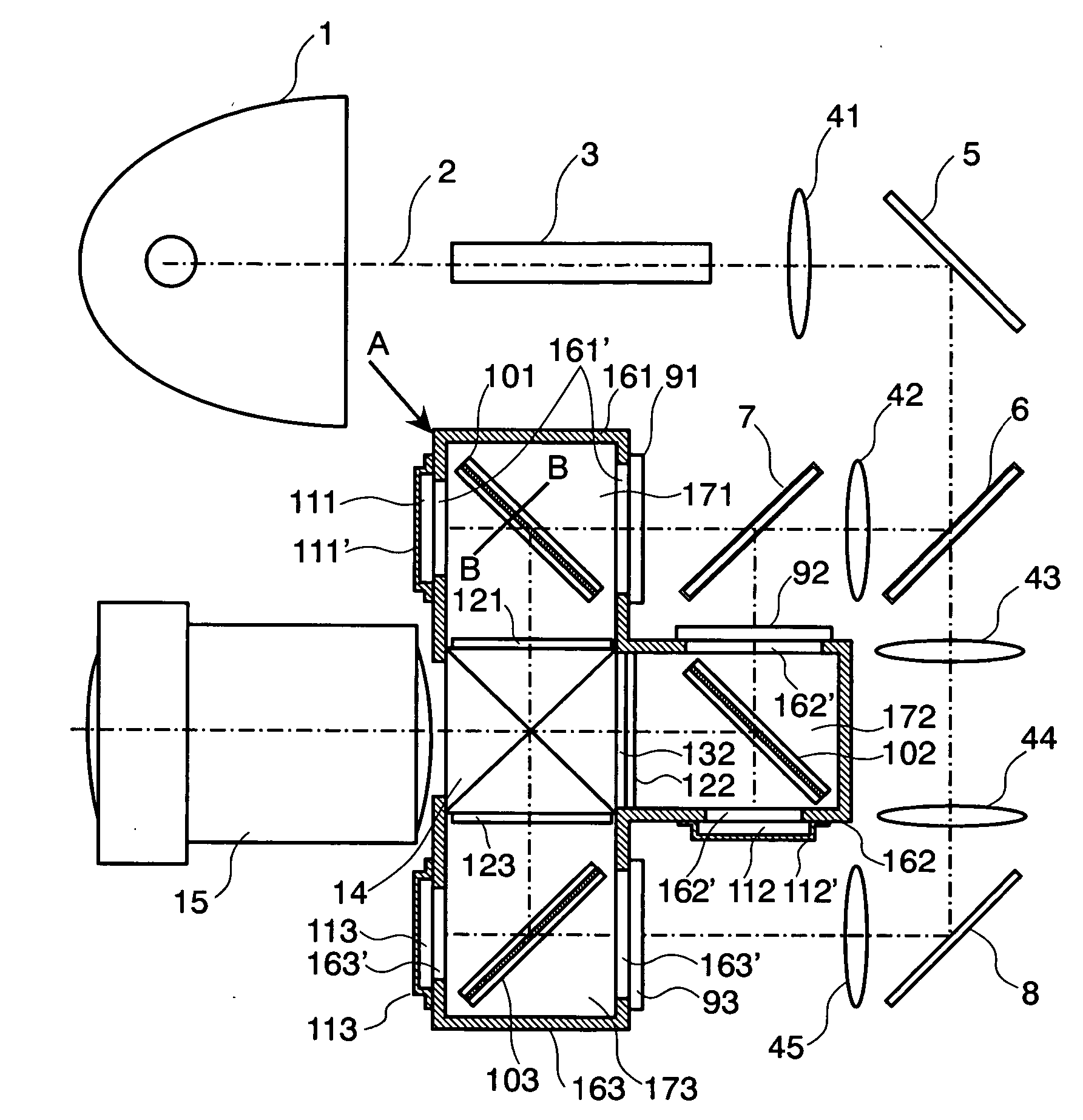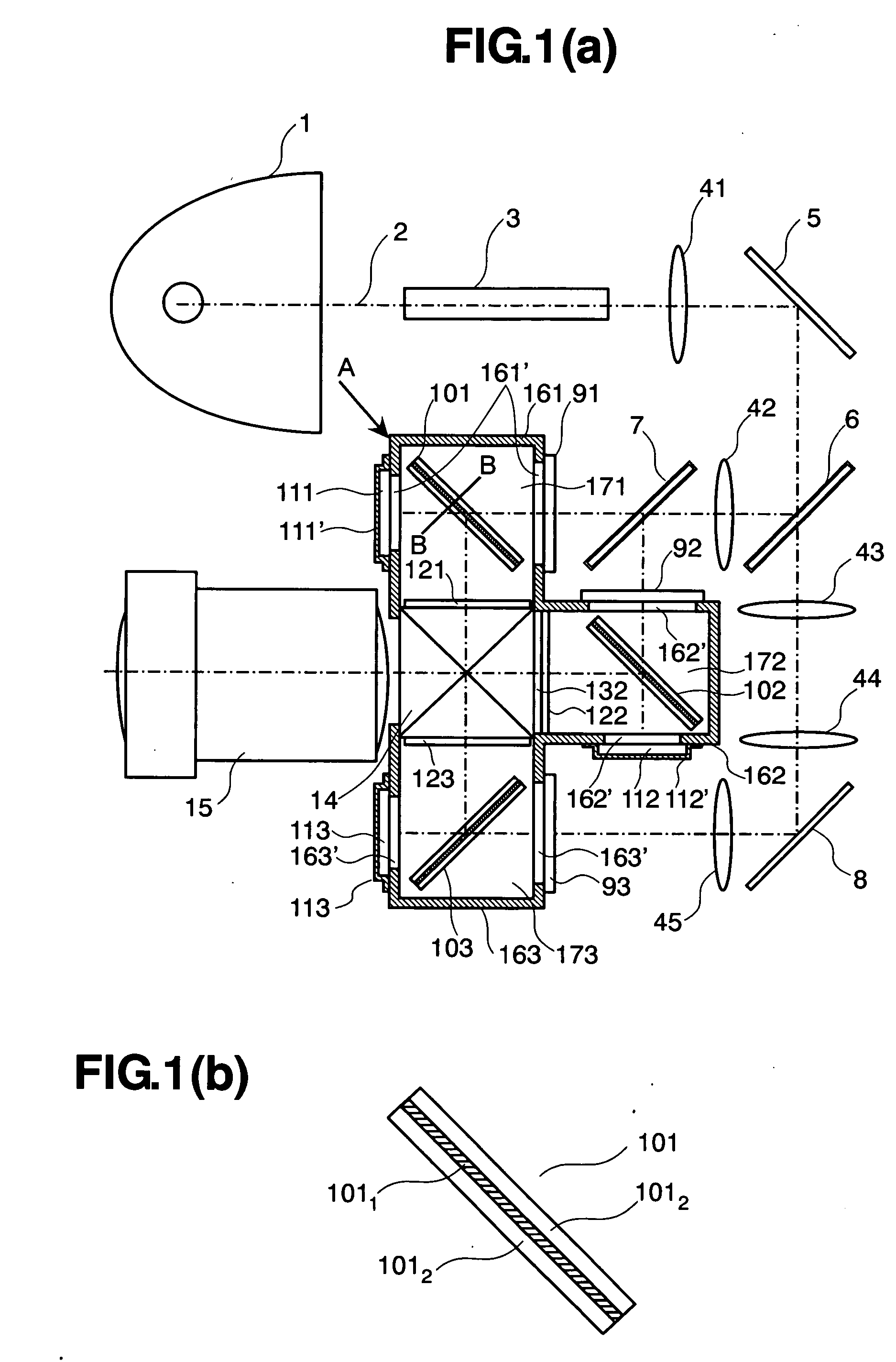Optical unit and pojection type image display unit using it
a projection-type image and optical unit technology, applied in optics, projectors, instruments, etc., can solve the problems of inability to obtain a sufficient brightness, low light utilization efficiency, and dust adhering to the surface so as to reduce the reflections on the boundary surfaces, shorten the optical length of the optical path, and prevent dust adhering to the surface.
- Summary
- Abstract
- Description
- Claims
- Application Information
AI Technical Summary
Benefits of technology
Problems solved by technology
Method used
Image
Examples
first embodiment
[0036] FIGS. 1(a) and 1(b) are views for showing an optical unit and a part thereof, according to the present invention, and FIG. 2 is a side view of an optical chassis portion shown in FIG. 1(a). However, FIG. 1(a) is a plane view of the optical unit, and FIG. 1(b) an enlarged structure view of a reflection-type polarization plate. Further, in those FIGS. 1(a) and 1(b) and FIG. 2, elements having the same functions to those shown in FIG. 8 mentioned above are attached with the same reference numerals thereof, and therefore the explanations thereabout will be omitted herein.
[0037] In those FIGS. 1(a) and 1(b) and FIG. 2, reference numerals 161, 162 and 163 depict a R-use optical chassis, a G-use optical chassis and a B-use optical chassis, respectively; 101, 102 and 103 a R-use reflection-type polarization plate, a G-use reflection-type polarization plate and a B-use reflection-type polarization plate, respectively, each applying a refraction grating therein; and further 171, 172 an...
second embodiment
[0064] Next, explanation will be made on a second embodiment according to the present invention.
[0065]FIG. 4 is a view for showing the optical unit according to the second embodiment of the present invention. In this FIG. 4, a reference numeral 16 depicts the optical chassis, and 17 the translucent liquid. However, in this FIG. 4, the elements having the functions same or similar to those shown in FIGS. 1(a) and 1(b) are attached with the same numeral references, and the explanation thereof is omitted herein. And, since the arrangement of the optical parts in this figure is also same to that of the first embodiment shown in FIGS. 1(a) and 1(b), and therefore the optical performances obtained therefrom are same to those; thereby omitting the explanation thereof. The description will not be made on effects thereof, but only new ones.
[0066] With this second embodiment according to the present invention, as is shown in FIG. 4, although being same to the first embodiment shown in FIGS. ...
third embodiment
[0069] Next, explanation will be made about a third embodiment according to the present invention.
[0070]FIG. 5 is a view for showing the optical unit according to the third embodiment of the present invention. In this FIG. 5, a reference numeral 216 depicts an optical chassis. However, the elements having the functions same or similar to those shown in FIGS. 1(a) and 1(b) are attached with the same numeral references, and the explanation thereof is omitted herein.
[0071] With this third embodiment, as shown in FIG. 5, changes are made on the arrangement of the R-use reflection-type liquid crystal panel 111, the G-use reflection-type liquid crystal panel 112 and the B-use reflection-type liquid crystal panel 113 in the second embodiment, so that they are in parallel with an incident surface of the cross dichroic prism, upon which the reflection light reflected upon each the liquid crystal panel is incident. Accordingly, differing from the first and second embodiments mentioned above,...
PUM
 Login to View More
Login to View More Abstract
Description
Claims
Application Information
 Login to View More
Login to View More - R&D
- Intellectual Property
- Life Sciences
- Materials
- Tech Scout
- Unparalleled Data Quality
- Higher Quality Content
- 60% Fewer Hallucinations
Browse by: Latest US Patents, China's latest patents, Technical Efficacy Thesaurus, Application Domain, Technology Topic, Popular Technical Reports.
© 2025 PatSnap. All rights reserved.Legal|Privacy policy|Modern Slavery Act Transparency Statement|Sitemap|About US| Contact US: help@patsnap.com



